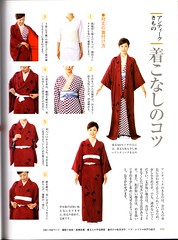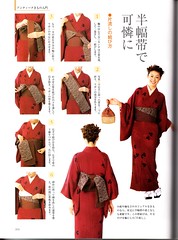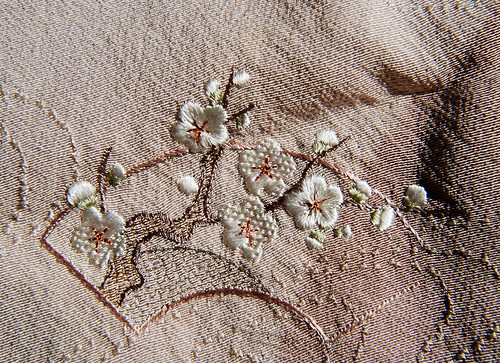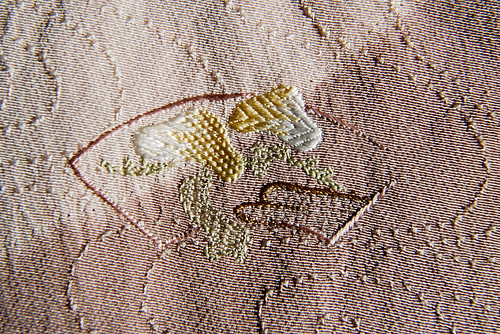Part I – Shop Smart
The subtitle of this blog, as you may have noticed, is A giantess’ adventure in tiny vintage silks. What you may not be aware of though, is how giant I really am. The photos I post are typically alone, and don’t offer much to scale against. I’d like to take a few entries to discuss the challenges of size in the hobby of kimono, since one of the regular excuses I hear for awkward or sloppy kitsuke is “Oh, I’m too big” or “Oh, I’m too curvy.” This first entry will focus on the kimono themselves, and shopping smart.
To start off, how big are we talking here? I am five feet ten inches tall. That’s 1.78 metres. I weigh roughly 175 pounds, or 79 kilos. My bust measurement is a cumbersome 46″ (117cm) around at the widest part. My bra size is currently averaging a 34F, though I recently bought a bra in a G-cup. Yes, you read that right. My waist is a reasonable 28″ (71cm) or so, and my hips are just passing the 40″ (104 cm) mark currently. My inseam when purchasing jeans is just over 35″ (89cm) high, from floor to groin. While this sounds like a figure most women would kill for (tall, long legs, big bust, small waist, rounded hips) it s by far the worst possible scenario for kimono.
So how then, do I manage to pull off wearing garments from a country where the modern national height average for women is 5’2″, or 1.58m, and a bra cup size of B is considered “large”?
The first, and easiest answer is to “buy big”. Modern everyday kimono are being made larger, to accommodate the fact that even women in Japan are significantly taller and wider than they were 50 or 100 years ago. However, this is not always an option, especially if you’re looking at older, one of a kind pieces. My best advice for this would be “don’t compromise.” That Taisho-era piece at a great price is still not a worthwhile investment if it’s so narrow at the hips that you can’t walk in it. If you truly have your heart set on vintage pieces, try looking for hikizuri – kimono meant to be worn trailing by either brides, geisha, or stage performers. Older ones are generally about the right length to be worn “normal style” by taller, modern women. In this outfit, I am wearing a vintage bridal hikizuri, which should have been worn without a fold at the waist and left trailing behind me. However, it’s just the perfect length for me to fold and wear normally.

When buying a kimono, the length should be the same as your height, the wingspan should be from wristbone to wristbone, and the hip wrap should be your own hip measurement multiplied by nearly 1.5 to get a full hip-to-hip overlap. Since I know there is no way I will ever accomplish this, I aim for kimono a minimum of 60″ or 150cm long, a wingspan of 50″ or 127cm, and a hip wrap of 45″ or 114cm. There is no sure set of measurements that are acceptably “too small”, it’s always going to relate to how comfortable and familiar you are with kimono to begin with, but for me, those dimensions are workable.
With tall height comes the all-important question – is ohashori truly necessary, if you find a kimono that’s wide enough but possibly too short? Nowadays, especially when it comes to wearing vintage pieces, the general consensus is that it’s not entirely necessary, especially for casual, everyday wear. So long as the rest of your kitsuke is entirely impeccable, and you’re ready and willing to back up and explain that it was a conscious descision, very few people (aside from perhaps notoriously fussy author of the Book of Kimono, Norio Yamanaka) are going to fault you.
Naomi has taken the time to scan some wonderful instructions on how to put on a kimono that is too short for full ohashori. Please click the small images for a link to her Flickr, where the full-sized ones are contained.


So there you have it – even Japanese kitsuke books are giving explicit instructions on how to dress, proving it’s not vital. Personally, I would not feel comfortable in a formal kimono (anything above an iromuji & fukuro obi combo) with no ohashori, but for everyday wear or going out to a casual dinner, it’s perfectly fine! A well-fitting kimono is ideal, but that’s no reason to leave things in the back of your closet or tansu. Work with what you’ve got! As soon as I get a few things in the mail I am going to be posting an outfit I’ve got planned out with a too-short kimono.
Since this is the first entry in a series, feel free to leave suggestions on how you accommodate a larger figure, or mention other things you’d like to see me discuss. The next entry I’ve got percolating is going to talk about foundation garments and padding, and why they’re so important.



































 Bebe Taian
Bebe Taian CHOKO Blog
CHOKO Blog Gion Kobu
Gion Kobu